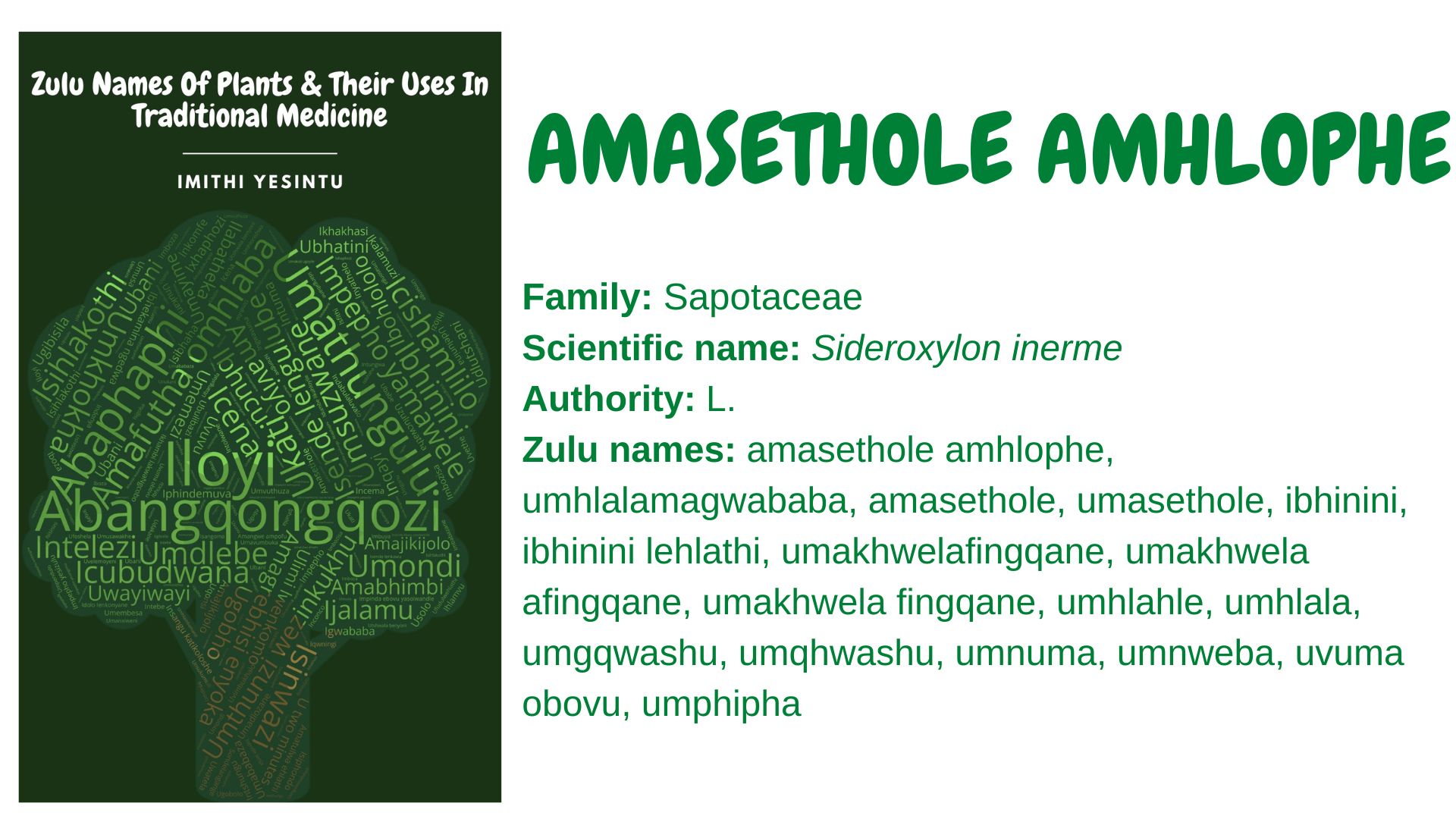Family: Sapotaceae
Scientific name: Sideroxylon inerme
Authority: L.
Synonyms: Calvaria inermis (L.) Dubard, Sideroxylon atrovirens Lam., Sideroxylon diospyroides Baker
Zulu names: amasethole amhlophe, umhlalamagwababa, amasethole, umasethole, ibhinini, ibhinini lehlathi, umakhwelafingqane, umakhwela afingqane, umakhwela fingqane, umhlahle, umhlala, umgqwashu, umqhwashu, umnuma, umnweba, uvuma obovu, umphipha
Other names: sneezewood
Plant description: S. inerme is a large evergreen tree. It has simple and leathery leaves with an entire margin, greenish white flowers, edible berry-like fruits that turn black when ripe with sticky juice, and one black seed. The tree produces milk sap and is found along the coast of South Africa from the Cape Peninsula to Northern Zululand.
S. inerme is a protected species in South Africa, despite not being endangered.
Uses:
- The roots are dried, ground to powder and mixed with Trichilia emetica seed oil. The mixture is applied to an incision on the broken skin and to heal broken bones.
- The roots are used to make a decoction and used as enema to cure influenza.
- The powdered roots are mixed with porridge and eaten to treat coughs.
- The leaf sap is used to treat sore eyes and inflammation, such as conjunctivitis.
- The roots are used to treat paralysis.
- The roots are used to make a paste for skin-lightening
- The bark is used as an ingredient to make umuthi omhlophe.
- The bark is used to make an infusion that is administered as an emetic.
- The bark is used to make a decoction that is used as an anthelmintic, to deworm humans and treat tapeworms.
- The bark is used to prepare a decoction that is used to prolong pregnancy to full term.
- The bark is used to make a tonic that is taken orally.
- The bark is used to treat burns and wounds.
- The bark is used to treat abdominal disorders such as hernias, gastric ulcers, and diarrhoea.
- The bark is used to treat male sexual problems and sexual diseases.
- The bark and roots are used to treat stomach ache, toothache, and headache.
- The bark is used to make a tonic and cleanse and purify the blood.
- The plant is used as an ethnoveterinary medicine to treat calves and goats. The bark is crushed and boiled for 20 minutes and the decoction given to cattle (200 ml in the morning) to treat redwater or gallsickness.
- The bark is used to make a decoction that is administered as an emetic that is used to get rid of idliso.
- The bark is used as an emetic to treat chest problems associated with food poisoning.
- The bark is used to treat the symptoms of psychological problems
- The bark is used to make an infusion that is used to dispel bad dreams.
Safety precaution:
Using traditional medicine responsibly can enhance your overall health and well-being. Misuse and abuse can lead to complications. You can inquire about the correct use of traditional medicine from a knowledgeable herbalist and practitioner. You can also visit imithiyesintu.co.za or email: info@imithiyesintu.co.za to learn more about traditional medicine
References and further reading:
- Chhabra, S. C., Mahunnah, R. L. A., and Mshui, E.N., 1993. Plants used in traditional medicine in Eastern Tanzania. IV. Angiosperms (Sapotaceae to Zingiberaceae). Journal of Ethnopharmacology 39, pp. 83–104.
- Corrigan, B.M., Van Wyk, B.-E., Geldenhuys, C.J., and Jardine, J.M., 2011. Ethnobotanical plant uses in the KwaNibela Peninsula, St Lucia, South Africa. South African Journal of Botany 77, pp. 346–359.
- Cunningham, A.B., 1988. An investigation of the herbal medicine trade in Natal/KwaZulu. Institute of Natural
- Gerstner, J., 1941. A preliminary checklist Zulu names of plants with short notes. Bantu Studies.
- Lin, J., Puckree, T. and Mvelase, T.P., 2002. Anti-diarrhoeal evaluation of some medicinal plants used by Zulu traditional healers. Journal of Ethnopharmacology, 79(1), pp.53-56..
- Mhlongo, L.S. and Van Wyk, B.E., 2019. Zulu medicinal ethnobotany: New records from the Amandawe area of KwaZulu-Natal, South Africa. South African Journal of Botany, 122, pp.266-290.
- Momtaz, S., Mapunya, B.M., Houghton, P.J., Edgerly, C., Hussein, A., Naidoo, S. and Lall, N., 2008. Tyrosinase inhibition by extracts and constituents of Sideroxylon inerme L. stem bark, used in South Africa for skin lightening. Journal of ethnopharmacology, 119(3), pp.507-512.
- Ngueyem, T.A., Brusotti, G., Caccialanza, G. and Finzi, P.V., 2009. The genus Bridelia: A phytochemical and ethnopharmacological review. Journal of ethnopharmacology, 124(3), pp.339-349.
- Palmer, E, and Pitman, N. 1972c. Trees of Southern Africa; AA Balkema: Cape Town, South Africa, 258-269.
- Pooley, E., 1993. The complete field guide to trees of Natal, Zululand and Transkei. Natal Flora Publications Trust, Natal Herbarium, Durban.
- Shelembe, B.G., Moodley, R. and Jonnalagadda, S.B., 2016. Secondary metabolites isolated from two medicinal plant species, Bridelia micrantha and Sideroxylon inerme and their antioxidant activities. Acta Pol. Pharm. Drug Res, 73, pp.1249-1257.
- Resources Investigative Report Issue 29. Institute of Natural Resources, Pietermaritzburg.
- Watt, J.M., and Breyer-Brandwijk, M.G., 1962. Medicinal and poisonous plants of southern and eastern Africa, second edition. Livingstone, London.
You Can Order Your Copy Of The Book By Emailing: info@imithiyesintu.co.za
Feel Free To Add Other Uses Of This Plant In The Comment Section Below:

